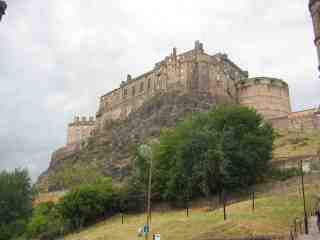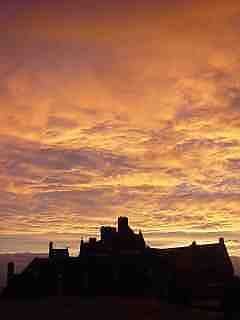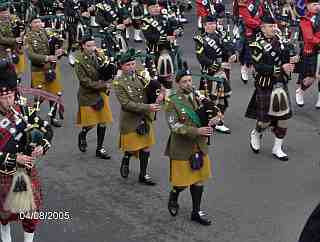
| 2005 Edinburgh Military Tattoo - Page 4 |  |
 That first time as you can imagine for a bunch of South Africans the prospect of
seeing this near mythical castle for the first time pushed the excitement levels
to a new high, with some of the younger members going "there it is, there it is"
only to be bought down to earth by the grumpier old salts who had been there before
with "ya but soon you will hate the sight of it". The buses coordinated by the Brit
military police are herded onto the esplanade in what can only be described as a
"military exercise" in that it looked impossible to begin with but somehow worked.
Its only when all the busses were stationary that we were allowed to disembark and walk for the first
time across the drawbridge and through the gatehouse into the castle.
That first time as you can imagine for a bunch of South Africans the prospect of
seeing this near mythical castle for the first time pushed the excitement levels
to a new high, with some of the younger members going "there it is, there it is"
only to be bought down to earth by the grumpier old salts who had been there before
with "ya but soon you will hate the sight of it". The buses coordinated by the Brit
military police are herded onto the esplanade in what can only be described as a
"military exercise" in that it looked impossible to begin with but somehow worked.
Its only when all the busses were stationary that we were allowed to disembark and walk for the first
time across the drawbridge and through the gatehouse into the castle.
 "By the centre, quick march" was the command and with the usual double set of
three beat rolls we were off. Now its worth pointing out that there were 15
pipe bands in attendance who had to all go through an opening maybe 4 meters
wide and 20 meters long, it was a pretty tight squeeze. Once inside the tunnel
leading out to the esplanade military order became more like the first day of
the post Christmas sales with pipers and drummers elbowing, pushing, shoving
and all making a concerted effort to stay on their feet as falling meant
certain death and burial in a low pancake shaped casket! The sound however
combined with the sense of arrival cannot be described to the layperson, impossible!
Better than sex, better than the cigarette after sex or even the
cigarette after a meal, better even than riding an 1100cc motorcycle without clothing
at 250 km/h down the N3 to collect your lottery winnings!
"By the centre, quick march" was the command and with the usual double set of
three beat rolls we were off. Now its worth pointing out that there were 15
pipe bands in attendance who had to all go through an opening maybe 4 meters
wide and 20 meters long, it was a pretty tight squeeze. Once inside the tunnel
leading out to the esplanade military order became more like the first day of
the post Christmas sales with pipers and drummers elbowing, pushing, shoving
and all making a concerted effort to stay on their feet as falling meant
certain death and burial in a low pancake shaped casket! The sound however
combined with the sense of arrival cannot be described to the layperson, impossible!
Better than sex, better than the cigarette after sex or even the
cigarette after a meal, better even than riding an 1100cc motorcycle without clothing
at 250 km/h down the N3 to collect your lottery winnings!
 This is where the narrator introduces us and we set off into the "formation set"
much like we had done at the barracks only this time we are encouraged to find
a visual marker to line up with so that you can ensure you are in a similar position each night.
This is where the narrator introduces us and we set off into the "formation set"
much like we had done at the barracks only this time we are encouraged to find
a visual marker to line up with so that you can ensure you are in a similar position each night.
 Now in position the first tune we played was Caledonia, which involved a rather
long-winded military band intro after which the pipers would come in. To a piper
coming into a tune midway is sometimes a challenge as we, unlike our brass band colleagues,
do not have the score with us to give us a cue. Instead we relied on the conductor
to make a fist as a cue. This was great if you could see him but as nothing is absolute
and your position on the esplanade could differ from show to show he wasn't always
visible so we took our cue from the pipers who could see. We were especially thankful
during "Band of Brothers", the next number, for the conductor as the pipers had to
come in three times during the tune whilst the Tattoo honour guard from the Royal
Navy march between our ranks to the front of the Tattoo. To do this some of the
pipe bands had to sneak rather casually behind the brass bandsmen next to them to
make an aisle wide enough for the honour guard. Once they reached the front of the
Tattoo they halted presented arms and it was time for the National Anthem. Next came
"Auld Lang Syne" which involved the military bands playing the whole tune once and
the pipes and drums coming in for the repeat, which sped up in the second part and slowed right down at the end.
Now in position the first tune we played was Caledonia, which involved a rather
long-winded military band intro after which the pipers would come in. To a piper
coming into a tune midway is sometimes a challenge as we, unlike our brass band colleagues,
do not have the score with us to give us a cue. Instead we relied on the conductor
to make a fist as a cue. This was great if you could see him but as nothing is absolute
and your position on the esplanade could differ from show to show he wasn't always
visible so we took our cue from the pipers who could see. We were especially thankful
during "Band of Brothers", the next number, for the conductor as the pipers had to
come in three times during the tune whilst the Tattoo honour guard from the Royal
Navy march between our ranks to the front of the Tattoo. To do this some of the
pipe bands had to sneak rather casually behind the brass bandsmen next to them to
make an aisle wide enough for the honour guard. Once they reached the front of the
Tattoo they halted presented arms and it was time for the National Anthem. Next came
"Auld Lang Syne" which involved the military bands playing the whole tune once and
the pipes and drums coming in for the repeat, which sped up in the second part and slowed right down at the end.